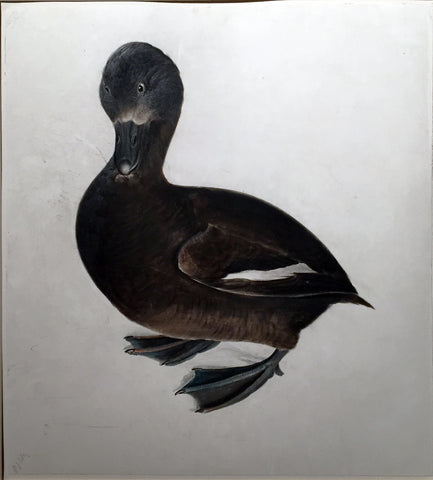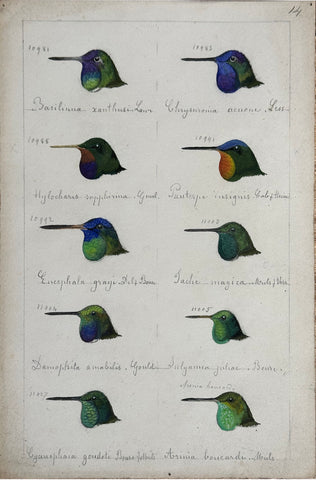
Prideaux John Selby (British, 1788-1867), “Velvet Scoter, Female”
Prideaux John Selby (British, 1788-1867)
“Velvet Scoter, Female”
Original watercolor for Illustrations of British Ornithology
Watercolor, gouache, grey and brown washes, pen and black ink on paper
Inscribed: plate 2.67
Signed bottom lower left: P.J. Selby
Paper size: 15 3/8 x 13 7/8 in.
Provenance: Collection of H. Bradley Martin.
Selby’s decription of the Velvet Scoter includes both male and female, but only the female is illustrated in our watercolor. He wrote of the Velvet Scoter, “This species is much larger than the preceding, and may always be distinguished from it by the form of the bill, as well as by the white band upon the wings, and a spot of the same colour at the posterior angle of the eye. It is a regular winter visitant upon our coasts, and frequents the same localities as the Black Scoter, with which it frequently associates, and to which it bears a close resemblance in its general habits. Its bill approaches in form nearer to that of Old perspicillata, the tubercle at the base not rising immediately in front as in Oid. nigra, but being double, and rising on the sides, where they, however, differ even from those of the former bird, in being partly covered by small feathers, and not left entirely exposed. TEMMINCK’S distinctive character of this species is therefore inapplicable, when he says, “ Bee sans renflemens lateraux.” The wings, also, of this and Oid. perspicillata differ in their proportions from those of Oid. nigra the first quill being longer than the second, and the longest in the wing. This feather also tapers gradually towards its point, without any notch or sudden decrease; and the tail, instead of sixteen, consists of fourteen feathers. The trachea is distinguished by two bony enlargements, the first of which is situated immediately below the larynx, of an oval shape, and in old specimens is nearly an inch in length. The second is about two-thirds down the trachea, where it suddenly swells out into a large rounded capsule, flat on one side, and convex on the other; the bone of divarication, where the rings become lost, being, in old birds, slightly swollen on each side, where the bronchi, which are of small diameter, are attached to it. The Velvet Scoter is found in all the northern parts of Europe, and its winter migration to warmer latitudes is regulated by the severity or mildness of the season. It is also very abundant in all the Arctic regions of Asia, where, in Kamtschatka, Siberia, &c. it is reported to breed upon the banks of the larger rivers, within the ‘effects of the tide. The nest is formed of grass, and lined with down, and the eggs, from eight to ten in number, are white. It is met with also in North America. Its flesh is as unpalatable as that of the Black Scoter, on which account it is seldom pursued by the fowler, but is occasionally caught in the stake-nets set for fish. In those which I have dissected, the gizzard, which is large and strong, was filled with the remains of mytilus, mactra, solen, and other shelly mollusca, intermixed with the spawn of fish or crustaceous animals.
PLATE 67. Represents the Male and Female of the natural size. The plumage of the male bird is of an intense velvet-black, with the exception of the spot at the posterior angle of the eye, and the secondary quills, which are white. Upper part of the base of the upper mandible, nostrils, and margins of both mandibles, black; the rest of the bill, including the lateral tubercles, bright orpiment-orange, with the tip of the nail darker. Inner part of the tarsus carmine-red, the outer part, and toes, orange-red, with the membranes of the toes black. The whole of the upper parts of the body are uniform.
Female. pitch (or brownish) black, the under parts much lighter. Between the bill, the eyes, and the auriculars, is a patch of greyish-white. Bill blackish-brown. Legs and toes dull brick-red.
The young males are like the females till after the second moult.”
Considered by many as the English equivalent of Audubon, Prideaux John Selby created some of the most memorable bird images of the nineteenth-century. His contributions to British ornithology were rivaled only by those of John Gould. Yet, his pictures were larger and less purely scientific, exhibiting Selby’s distinctive and charming style. A sense of Selby’s enthusiasm for his subjects is nowhere more palpable than in his engaging original watercolors. Selby executed these delightful images as preparatory models for his landmark printed series, Illustrations of British Ornithology. While the artist’s engraved work is highly desirable to collectors, Selby’s original watercolors rarely become available. This selection of watercolors, moreover, comprises several of his masterpieces. The distinctive birds are depicted in profile, their forms delineated by softly modulated tones of black and gray wash. The setting, if present, is lightly but skillfully painted to not distract from the birds themselves. The skill and delicacy of Selby’s touch, his keen powers of observation, and his artistic sensitivity are conveyed here in a way they are not in his printed work. Several of the drawings are by Selby’s brother-in-law, Robert Mitford, but signed in Selby’s hand.
Born in Northumberland and educated at University College, Oxford, Selby was a landowner and squire with ample time to devote to studying the plant and animal life at his country estate, Twizell House. As a boy, he had studied the habits of local birds, drawn them, and learned how to preserve and set up specimens. Later, Selby became an active member of several British natural history societies and contributed many articles to their journals. Although Selby was interested in botany and produced a History of British Trees in 1842, he is best known for his Illustrations of British Ornithology. Selby’s work was the first attempt to create a set of life-sized illustrations of British birds, remarkable for their naturalism and the delicacy of their execution. The British Ornithology was issued in nineteen parts over thirteen years; the book consisted of 89 plates of land birds and 129 plates of water birds, engraved by William Lizars of Edinburgh, the printer who engraved the first ten plates of Audubon’s Birds of America.
With their rich detail and tonal range, these exquisite watercolors are beautiful works by one of the foremost British bird painters. Furthermore, they represent a singular opportunity to obtain a unique piece of the highest quality by this luminary artist, from an era in British ornithological art that remains unparalleled.
Please feel free to contact us with questions by phone at 215.735.8811,
or by email at loricohen@aradergalleries.
We Also Recommend





